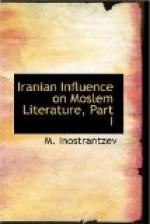I am less certain about the name Danishwar. It was probably an adjective signifying “possessed of knowledge.” It was easy for anyone who knew from Firdausi that the landed nobility called the Dihkan constituted the peculiar custodians of national lore to name a “learned Dihkan” as the collector of the stones of kings.
The compilation prepared at the time had undoubtedly drawn upon written documents without which It would have been impossible to give minute particulars of a long by-gone past. Besides the brief notices communicated by the Syrian Sergius to Agathias from the Basilika apomnemoneiumata are in the main in unison with our Arabo-Persian stories. Thus then in Khushro’s time there existed a general survey of the history of Persia more or less in an official version. But otherwise there is no need to lay stress on the mention of Khushrau here, for all manner of things beneficial and good are ascribed to this king.
[Sidenote: Nature of the Khoday Nameh.]
The book of kings contains, as we said, the story of Persia from the creation of the world to the fall of the last purely national domination. It made no distinction between wholly mythical, semi-fabulous, and fully historical dynasts, so that the Arabs and Persians who drew upon it never suspected that e.g., Hoshang and Rustam are not such historical persons as Shahpur I and Bahram Chobin. But in the material itself we notice a conspicuous difference. The mythical tales which in their crude nascent forms were already there at the period of the Avesta were in course of time richly developed and under the Sasanides were no doubt universally known. To these were joined ecclesiastical speculation and traditions concerning the genesis of the world, civilisation and the legislation of Zoroaster. There were also several genealogical trees. In all these at the most a few proper names were historical. Of the empires of the Medes and of Persians proper this tradition had no knowledge. It is doubtful if it contained even quite a feeble reflex of the last days of the Achaeminides. On to this ancient autochthonous tradition was immediately joined the story of the last Darius and Alexander emanating from a foreign source, the Greek romance of Alexander. Not more than a few names was all that was preserved of the long period covering the




